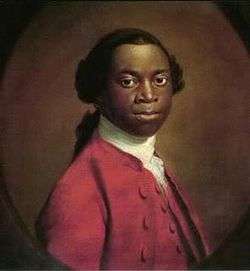Black Company of Pioneers
| Black Company of Pioneers | |
|---|---|
|
A color drawing, of a soldier, from the "Company of Black Pioneers" who were also, known as Black Pioneers, being Black Loyalists, who served with the British Army, during the American Revolutionary War, their purpose being non-combatants, to provide manual labor for a variety duties. Pioneers were soldiers employed to perform engineering and construction tasks. The Pioneers wore black, wool, tricorn hats and blue, wool, short coats, that retained the former, Ethiopian Regimental motto, which embroidered on their uniforms: "Liberty to Slaves." | |
| Active | 1777-1783 |
| Country |
|
| Allegiance |
|
| Branch | British provincial unit |
| Type | labor detail, (auxiliary troops) |
| Role | construction, street cleaning, garbage collection |
| Size | company (50-70) |
| Nickname(s) | Black Pioneers, Clinton's Black Pioneers |
| Motto(s) | Liberty to Slaves |
| Engagements | No combat experience, accept for former soldiers, coming from the disbanded Ethiopian Regiment |
| Commanders | |
| Notable commanders |
General Sir Henry Clinton |

The Black Company of Pioneers also, known as the Black Pioneers and Clinton's Black Pioneers, were a British Provincial military unit, raised for Loyalist service, during the American Revolutionary War. The Black Loyalist company was raised, by General Sir Henry, as a non-combatant, replacement force, for the disbanded Ethiopian Regiment, in Philadelphia, in late 1777 or early 1778. Pioneers were soldiers employed to perform engineering and construction tasks. Clinton refused to allow black and white soldiers, to serve together as integrated, Loyalist, military units, In 1778, The Pioneers merged, into the Guides and Pioneers led by Colonel Beverley Robinson, in New York. Its company commanders were Captain Allen Stewart and Captain Donald McPherson. In 1783, the company was disbanded in Port Roseway, Canada, now Shelburne, Nova Scotia.
Company formed
The Black Pioneers were an African American military unit, established, in May 1776, out of Lord Dunmore's disbanded Loyalist unit, the Ethiopian Regiment. The Pioneers retained the Ethiopian regimental motto, which was embroidered on their uniforms: "Liberty to Slaves."[1]
Duties of service
During the American Revolution, the Black Pioneers would "Assist in Cleaning the Streets & Removing all Nuisances being thrown into the Streets."[2]The company followed the British troops, under the command, of General Clinton, as they moved, from New York to Philadelphia, to Charleston, and, after the fall of Charleston, back to New York, once again.[2]
Commanders
The Black Pioneers were commanded, for a time, by Major James Moncrief, of the Royal Engineers. Moncrief had great faith in, the ability of, African-American slaves to fight. In a letter to Clinton, at the close of the war, he offered to continue the war, with a brigade of African American troops. He also, advocated for their freedom, in light of their service in the British Army. One of the most famous commanders, of the Company of Black Pioneers, was Colonel Stephen Blucke, who commanded them, for a number of years. In 1780, Blucke would, go on to, command the infamous, Black Loyalist, guerrilla, associators, the Black Brigade, after their beloved, Colonel Tye, died of his wounds. Blucke received the honorary rank of "Colonel".
Uniforms
The Pioneers wore black, wool, tricorn hats, trimmed with white bunting, black spatterdashes, and blue, wool, short coats, that retained the former, Ethiopian Regimental motto, which embroidered on their uniforms: "Liberty to Slaves."
Weapons
The Black Company of Pioneers, may have been trained to use the standard, British Army-issue, Brown Bess musket.
Military recruitment, evacuation, and resettlement of escaped, American, Loyalist slaves

One recruit was the former slave of General George Washington. After Lord Dumore's proclamation of freedom to escaped slaves that helped the British Army, Henry Washington ran away from Washington's Mount Vernon plantation to join the Black Pioneers in 1776. After the Pioneers arrived in New York in 1783, many former slaves escaped from the harbor, in fear of being repossessed by their former masters. It is still unknown how many former slaves escaped from New York during this period, although at the end of the war the evacuation of British forces involved approximately 15,000 African Americans.
Tens of thousands of slaves escaped during the war and joined the British military; others simply moved off during the chaos. In South Carolina, nearly 25,000 slaves, being 30% of the enslaved population, fled, migrated, or died from the disruption of the war. When the British withdrew their forces from Savannah and Charleston they also evacuated 10,000 slaves belonging to Loyalists.[3]
The British evacuated nearly 20,000 blacks at the end of the war. More than 3,000 of them were freedmen and resettled in Nova Scotia, many, under the leadership of Stephen Blucke, a prominent Black leader of the battalion.[4]
Notable Black Pioneers
See also
- Black Nova Scotians
- Merge article into Black Company of Pioneers
References
- ↑ Goodbye, Columbus When America won its independence, what became of the slaves who fled for theirs? Lepore, Jill
- 1 2 Lepore, Jill
- ↑ Peter Kolchin, American Slavery: 1619–1877, New York: Hill and Wang, 1994, p.73
- ↑ William Weir (2004). The Encyclopedia of African American Military History. Prometheus Books. pp. 31–32.
External links
- Index to Black Pioneers History - The On-Line Institute for Advanced Loyalist Studies
- Black Soldiers - The American Revolution: War of 1812 - National Park Service
